PDF version [PDF:500KB]
The Covid-19 pandemic has brought dramatic changes to our lifestyles, businesses, communications, and all manner of human activity. From the current situation in autumn 2020, there is still a long way to go to eradicate the virus. Combating this infectious disease is becoming a new policy challenge across the world. Simultaneously, governments must continue to tackle conventional policy challenges.
Japan is one of the leading developed countries that have started to experience population decline. Along with the aging of its population and low birth rate, the labor shortage is one of the most worrisome problems for the Japanese economy. The situation is already worse in rural areas that permanently face outflows of younger people. Although the government has taken various measures to address the labor shortage (e.g., raising the birthrate, encouraging more women and elderly people to work, promoting engagement in side jobs along with concurrent jobs, introducing advanced technologies such as artificial intelligence and robotics, and expanding the acceptance of foreign workers), the Japanese economy has failed to grow as expected. Finding effective policies is an urgent task for the government, but it is in this situation that the Covid-19 pandemic occurred.
How does Covid-19 change conventional policy challenges? Do we need "new normal" policy measures that are radically modified? The answer is no. Although some new policy schemes may be required to sustain the economy from the sudden economic shocks (e.g., some experts suggest a universal basic income), the conventional policy measures that the government has discussed up to now, such as work style reform, regional revitalization, digital transformation (DX), education in data science for the age of AI and robotics also play an important and effective role in combating infectious disease. Thus, the goal of this article is to disentangle the possible policy movements in 2021 along with a recent Cabinet Office survey conducted during the pandemic (https://www5.cao.go.jp/keizai2/manzoku/index.html). Especially, I focus on how the Covid-19 pandemic will reshape the urban-rural relationship in Japan.
Were Advantages of Large Cities Lost by Covid-19?
Academic research on urban economics has revealed that workers and companies benefit from locating in large cities. Workers in larger cities can earn higher wages than in smaller cities. Employees could enhance their working capacity effectively by working in large cities because they have many opportunities to be exposed to cutting-edge technology and to valuable and unique experiences. Companies also benefit from larger markets by taking advantage of economies of scale. Consumers in large cities can enjoy a variety of goods and services that are not provided in small cities. As such, urban economists have emphasized the economies of density, agglomeration economies, scale economies, face-to-face communication for knowledge creation, and benefits from geographical proximity in knowledge spillover to explain why large cities attract more people and companies. These advantages make large cities grow much larger through the circular causality. On the other hand, small cities suffer from the population outflow. This human migration explains the simultaneous progress of the monopolar concentration in Tokyo and depopulation in rural areas.
What is the economic impact of the Covid-19 pandemic on the advantages of large cities? Combating infectious diseases requires a strong restriction of close face-to-face contact in closed spaces and crowded places. In fact, the Covid-19 infections are mainly spreading in large cities, such as in Tokyo's 23 Wards, Osaka, Yokohama, Saitama, Chiba, Nagoya, Fukuoka, and Sapporo, where social and economic activities are concentrated in limited geographical spaces. Commuting by public transportation is also one of the biggest risks for infection of workers as well as students. Therefore, the government requests that people stay home, work from home, promote online classes, and avoid face-to-face meetings. Obviously, these measures for combating infection impede the advantages of large cities mentioned above and force the economy into a slowdown.
Can Urban-to-Rural Migration Combat Infectious Disease?
If the advantages of large cities are lost, should our economic activities be dispersed from urban to rural areas? In the next decade, urban-to-rural migration may be a coming trend. However, the regional dispersion of economic activities is not the fundamental solution for combating infectious diseases. Urban and rural areas are always connected: the outflow from urban areas simultaneously increases the inflow into rural areas (unless people emigrate). Although many people in urban areas consider that rural areas are much safer, the risk of infection will increase in rural areas owing to additional population inflows.
Current urban policy in Japan promotes compact and networked cities. For example, the Location Normalization Plan managed by the Ministry of Land, Infrastructure, Transport and Tourism requests residents to live in the areas designated by each local government. Businesses and hospitals are also required to concentrate in central business districts or their neighboring areas. These localized areas are connected by public transportation. Thus, residential locations and economic activities in rural areas do not necessarily ensure less crowded places. Offices, schools, hospitals, and social facilities still have the characteristics of close face-to-face contact, closed spaces, and crowded places.
We should note that the policy for regional reallocation of residents simply involves certain risks and does not provide a fundamental solution for combating Covid-19. In other words, rural areas take on the infection risks of urban areas. As residents in urban areas feel a greater burden from the pandemic, urban-to-rural migration partly mitigates their risk of infection. But what is important in combating an infectious disease is to prevent close contact and concentration of people in crowded places, regardless of urban or rural area.
Changes During the Covid-19 Pandemic
Combating an infectious disease requires not having close face-to-face contact in closed spaces and crowded places. In addition, commuting and traveling should be subject to restrictions so as not to spread the virus across cities. However, most of our social and economic activities rely on face-to-face contact and interregional mobility. The restrictions on our social and economic activities force the economy into a slowdown. In addition, essential workers, such as medical service workers, cashiers, and taxi drivers, are exposed to higher risks of infection.
Although there are some jobs fully requiring face-to-face contact, other jobs can prevent this. Many social and economic activities have been switched to be conducted through the Internet. Effective use of information and communication technology (ICT) allows us to continue our social and economic activities.
The introduction of teleworking and online meetings has accelerated since the Covid-19 pandemic, and this contributes to mitigating the spread of the virus. Online classes have also started, reducing the spread of infection between teachers and students. Online medical diagnosis has also been accelerated, which prevents infection between medical service workers and patients. Of course, there is still plenty of room for improvement, but our society and economy are advancing gradually under a "new normal" environment.
What I wish to emphasize here is that the "new normal" is nothing new in terms of the policy agenda. For example, teleworking is recommended in the work style reform. Because female workers mainly take care of their children, long-distance commuting is a big obstacle for them to continue to work after having children. So teleworking can be viewed as a helpful way to save time and mitigate anxieties over child-raising during working hours. Online education is also one of the policy challenges that the government has tackled. On this point, Japan is behind compared to other developed countries. Online medical diagnosis has been already started from April 2018.
Importantly, conventional policy measures that the government has discussed before the Covid-19 pandemic can simultaneously help resolve the spread of infections. Therefore, the prospect in 2021 is that private and public sectors will work cooperatively toward an early realization of the conventional policy goals.
Prospect of Regional Revitalization & Digital Transformation
The government has accelerated policy efforts for regional revitalization since the Headquarters for Overcoming Population Decline and Vitalizing Local Economy was established in September 2014. However, the Greater Tokyo area has attracted even more people from other regions. Will the trend of monopolar concentration in Tokyo change? Or must this trend change to combat infectious diseases? Masahisa Fujita and Nobuaki Hamaguchi ("Transforming the three C's into Urban Advantages: Population Concentration and Infection Risks," The Nikkei, July 8, 2020) propose that promoting regional dispersion serves to combat an infectious disease. More importantly, they are concerned that the monopolar concentration in Tokyo will bring about a uniform culture and society, which could prevent high creative activity in the future. They propose that decentralization must be promoted to improve economic and social diversity and combat infectious diseases.
I agree that regional revitalization will bring about a better society in Japan over the long term. But as mentioned earlier, we should understand that it is not the role of rural areas to accept the burden of the spread of infection that occurs in urban areas. Policies should be planned in order that rural areas can promote economic growth during the Covid-19 pandemic.
The key movement is DX, which enables people to work efficiently and effectively along with combating the spread of infections. DX is one of the new policy challenges that the government discussed before the pandemic. Because face-to-face contact causes the virus to spread, the promotion of telework can combat this. It could also encourage urban-to-rural migration because living in urban areas becomes less important with teleworking, which can reduce the burden of daily commuting. Encouraging workers who can telework to reside in rural areas could lead to economic promotion there because of increasing money flows from urban to rural areas.
Using the recent Cabinet Office survey, I tried to assess the possibility of a coming trend of urban-to-rural migration and the importance of DX. Chart 1 shows whether workers experienced telework during the pandemic according to city size. As evidenced by Chart 1, workers in larger cities tended to switch face-to-face working to teleworking. Especially, more than half of workers residing in Tokyo's 23 Wards had telework experience partially or completely. Chart 2 shows whether workers will continue to telework in the future according to city size. An interesting finding is that 38.4% of workers residing in Tokyo's 23 Wards wish to replace all or more than half of conventional work styles by telework, and this rate in small cities is 12.9%. In other words, workers in large cities believe their jobs or tasks can be conducted by telework through ICT and the Internet.
Chart 3 shows by what percent workers have reduced their commuting time per week during the Covid-19 pandemic. Some 38.2% of workers in Tokyo's 23 Wards reduced their commuting time by 50% or more, reflecting the fact that most of them worked from home. On the other hand, for 70.7% of workers in small cities commuting time only changed by up to 5%. Promotion of DX enables workers to live far from the central business districts as they do not need to commute for a long time every day.
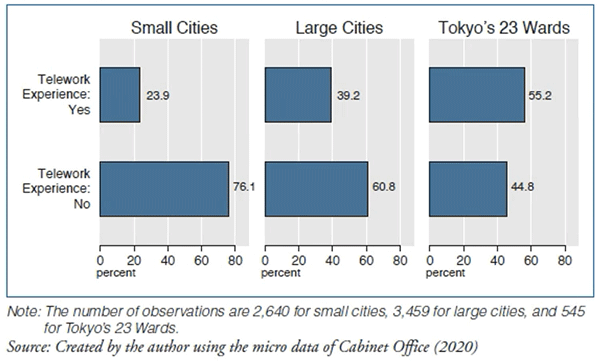
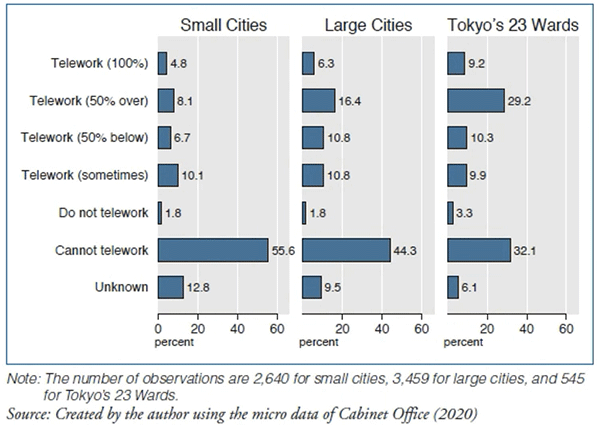
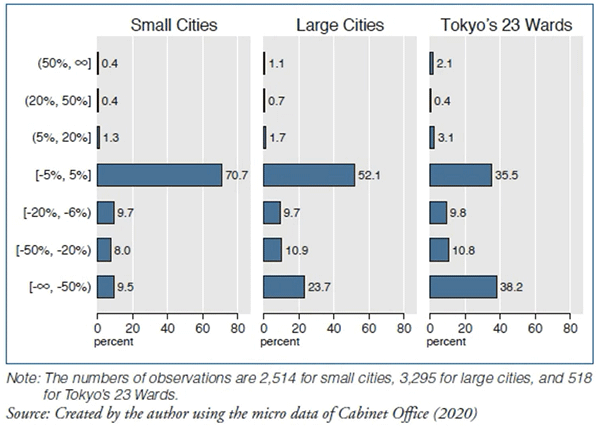
Chart 4 shows how interest in urban-to-rural migration has changed during the pandemic. The left panel presents the answers of those who had no telework experience, and the right panel presents the answers of those who did have telework experience. Note that respondents are limited to people who reside in the Greater Tokyo, Osaka, and Nagoya areas. A salient finding is that workers with telework experience show a twice higher interest in urban-to-rural migration, suggesting that the telework experience provides a motive to relocate.
From Charts 1, 2, 3 and 4, it is predictable that the promotion of DX will give incentives for workers to find more attractive places to live while working in the same companies. Workers wish to reduce the burden of daily commuting to achieve a better living standard if they can do their job by teleworking. They would also benefit from lower house rents in suburban areas if they can continue to earn the same level of wages by teleworking.
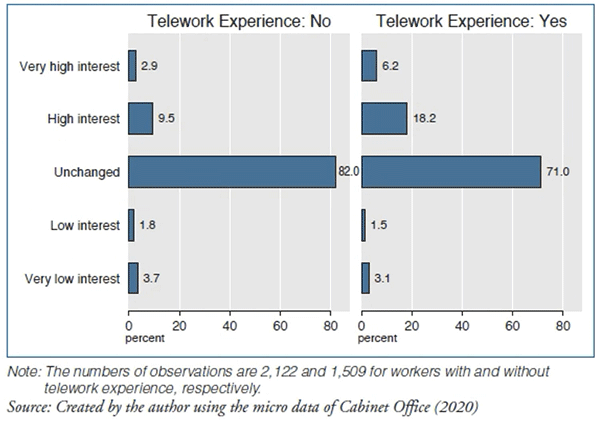
Prospect of GIGA School Concept
In my view, one of the most important policy agendas is how schools can promote effective education during the Covid-19 pandemic. Children are exposed to higher risks of educational opportunity gaps during the pandemic. In fact, there were many children who stopped their studies after the declaration of a state of emergency. Only some children who can access online learning materials could continue to study online at home. Thus, online education is an urgent task for educational policies. Simultaneously, schools should improve their ICT infrastructure and learn effective online teaching methods.
Online education is another of the policies the government discussed before the pandemic. The Ministry of Education, Culture, Sports, Science and Technology (MEXT) is promoting the Global and Innovation Gateway for All (GIGA) School Concept, which was spelled out in December 2019. It is planned that each student will be able to use each technological device connected with a high-speed network. The Covid-19 outbreak is pushing MEXT toward an early realization of the GIGA School Concept. It had previously not discussed combating infectious diseases and had just discussed ICT education and data science, but as the GIGA School Concept will also help combat the spread of the virus through online education, MEXT will address the issue with greater urgency.
Using the Cabinet Office survey, I shed light on how online education was provided by schools during the Covid-19 pandemic. Chart 5 shows the online class experiences of students during the pandemic. Panel (a) corresponds to high school students and Panel (b) corresponds to university students. I focused on the regional differences in online education opportunities. A notable finding is that the online class experiences of high school students differed between large and small cities. There are possible reasons for it. First, Covid-19 infection rates might not have been serious in small cities around May 2020, so there might have been high schools that decided not to switch face-to-face classes to online classes in small cities. Second, there might have been high schools that were not able to switch face-to-face classes to online classes in small cities owing to a lack of an online teaching environment and resources even though the infection was spreading at that time.
It is important to investigate further why these differences appeared between large and small cities. Most universities were able to start online classes regardless of whether they were in large or small cities. So there is a barrier that must be overcome for online education, especially for elementary and secondary education in small cities. The government should investigate what factors delay the start of online classes in small cities. Otherwise, the regional gaps in online educational environments will lead to widening the gaps in learning opportunities, being a bottleneck for further economic growth in small cities.
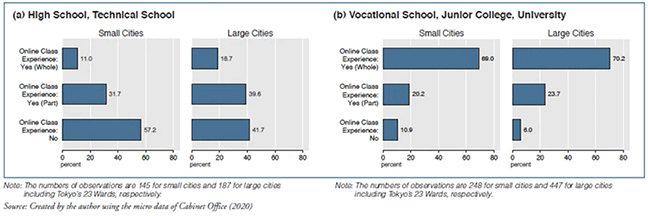
[Click to enlarge]
Conclusion
I have discussed how the Covid-19 pandemic is changing conventional policy challenges in Japan. My conclusion is that the government needs to forge ahead with its conventional policy measures, such as work style reform, regional revitalization, DX, and the GIGA School Concept. These can help solve long-term challenges and simultaneously contribute to mitigating the spread of the pandemic.
But short-term policy measures to tackle temporary economic shocks from the pandemic are also required. The infection situation is changing from day to day. Distinguishing between short- and long-term policy measures, the government needs to firmly push ahead in tackling conventional challenges. Furthermore, effective use of teleworking and online education will also reshape the urban-rural relationship, leading to the formation of multipolar sustainable cities in Japan. Regional revitalization contributes to reducing urban congestion problems, including the spread of infection and maintaining the unique traditions, cultures, and ideas of each regional society, as well as the diversity of all society, which plays an important role as a basis for the long-term prosperity of the country.
Appendix: Data Description of Cabinet Office (2020)
In this article, I use the anonymized micro data of the "Survey on Life Consciousness and Behavior Changes During the COVID-19 Pandemic" with permission (Cabinet Office, 2020). The survey was conducted online for those who were 15 years old and above, lived in Japan, and were registered as an online survey monitor. The total number of respondents was 10,128. The survey was conducted from May 25 to June 6 in 2020. The sampling method is designed in terms of the age, gender, and region. For the total number 10,128, equal numbers of responses were allocated by 12 age groups (15–19, 20–24, 25–29, 30–34, 35–39, 40–44, 45–49, 50–54, 55–59, 60–64, 65–69, and 70 over) and gender (male and female). The regional allocation of responses was based on the distribution of the residential population across seven regions (Hokkaido and Tohoku, Tokyo, Greater Tokyo region excepting Tokyo itself, Chubu, Kinki, Chugoku and Shikoku, and Kyushu and Okinawa). Out of 10,128, the number of workers was 6,865 and the number of students 1,035.
To focus on how differently the Covid-19 pandemic affects our life between urban and rural areas, I divided the sample in terms of the size of cities where the respondents reside. The survey asked about the respondent's residential prefecture and municipality, so I used the population and population density as a criterion of the city size from the 2015 Population Census (Ministry of Internal Affairs and Communications). The population was used as the municipal unit, and the population density calculated as a ratio of the population and habitable area including the neighboring municipalities within 30 kilometers of the center of the municipality. Based on the distribution of population and population density across 1,741 municipalities, I defined a large city as a municipality with a population of 75 percentile (63,471 persons) or over and population density of 75 percentile (1,581 persons per square km) or over. Out of 1,741 municipalities, 231 municipalities were selected as a large city. Generally, these municipalities include Tokyo's 23 Wards, 47 prefectural capitals, and regional core cities. There were 1,510 municipalities selected as a small city.
This article first appeared on the January/February 2021 issue of Japan SPOTLIGHT published by Japan Economic Foundation. Reproduced with permission.
January/February, 2021 Japan SPOTLIGHT


